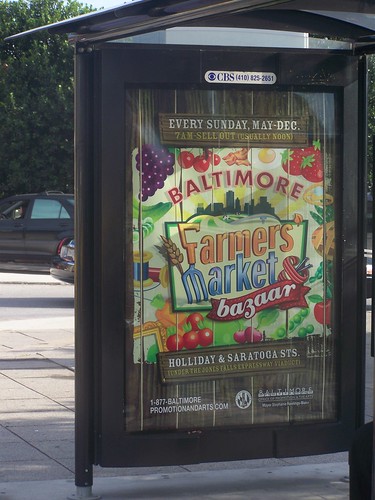Of course farmers markets draw few food stamp users
This entry is in response to the Associated Press article, "Farmers' markets draw few food stamp users," which has run in many papers across the country. (I read it first in the Chattanooga Times Free Press.)
For the most part, farmers markets aren't initiated by people interested in dealing with food security issues as much as they are by people interested in quality of life and foodways issues. And then there is the issue of marketing farmers markets generally, and to people with food stamps benefits specifically.
Baltimore is one of the only jurisdictions I've seen that does a nice job promoting farmers markets with a campaign using bus shelter ads. The ad doesn't promote food stamp use, but it could, easily, and both the Baltimore Farmers Market on Sundays and the 32nd Street/Waverly Farmers Market on Saturdays could modify their marketing some to include this.

Baltimore Farmers Market ad, bus shelter, Penn Station. They also had smaller ads that were posted in the small community promotional slot on the back of bus shelters.
I came up with a typology of why farmers markets are created a few years ago in association with a grantmakers conference by the Project for Public Spaces in 2007. (See the entry "A follow up on the Liberty Market closure.")
Basically the point comes down to recognizing that there are at least eleven reasons to open a market, and while the purposes intersect at times, it means that decisions about what is allowable to sell need to vary according to the purpose of the market. Plus, the goals may vary according to whether you are a sponsor, operator (sponsors and operators are not always the same), or participating vendor.
Potential reasons to have a "farmers" market
1. Provide fresh food that is locally grown, supporting local and regional food security and policy;
2. Provide access to less expensive food
3. Provide access to "more expensive food" i.e., "organically grown" -- access to food that might not normally be available locally, although this is changing in metropolitan markets
4. Build rural incomes
5. Provide fresh food in an area that otherwise has few stores selling fresh food
6. to promote health and wellness (this is why hospitals and health organizations may get involved such as Kaiser Permanente, which supports markets in the DC region, but is actively engaged in market activities in California, their home base)
7. to aid commercial district and/or neighborhood revitalization by building activities and a reason for people to come out, gather, and resample the place (placemaking)
8. to promote entrepreneurship and local business development (e.g., some businesses, such as the Chateau Animaux pet store on 8th St. SE grew out of Eastern Market)
9. to promote a business and/or add additional revenue streams to a wholesale or retail business (e.g., Atwater's Bakery, based in Baltimore County, with three or four retail stores in the City and County, has a major presence in many markets throughout the Baltimore-DC region; Uptown Bakery, based in Hyattsville, is a wholesale bakery, but they allow their employees to sell products at farmers markets--while I don't know of many instances where they do it, Uptown products are sold at the Waverly Market in Baltimore)
10. to promote economic, environmental, and energy "sustainability"
11. as a property management tool/to generate rental income
12. as a for profit business venture
(11) and (12) might not be considered by some to be "legitimate" reasons for running markets, but the markets in Mt. Pleasant, U Street, and Bloomingdale are run by a for profit operator, which in part is an indicator that the sponsor of the market might have different goals from the operator of the market.
At best, providing access to fresh food for food stamp users is related to purposes one, two, five, and six but that leaves eight other potential organizing reasons for creating a farmers market.
Many markets develop programs to support food stamp users. The USDA has a program that supports the provision of EBT/ATM hookups at markets, although the management requirements are incredibly onerous and the equipment is expensive and given the limited usage, too costly for most market sponsors to handle without subsidies.
A major problem of course is that the markets typically are not located where food stamp users live. And frankly, most producers are interested in having markets where they are more likely to be able to sell for higher prices. And in DC, the organic markets such as Takoma Park Farmers Markets and the ones run by FreshFARM Markets have more expensive food anyway.
If you are going to recommend that food stamp users maximize the amount of food they purchase, you ought to recommend that they go to either lower cost public markets like the DC Farmers Market in Florida Market or to lower priced "ethnic" grocery stores such as PanAm International, where the food is priced much cheaper, but won't be sourced from a local farmer.
See "A World of Bargains: Asian Markets Attract Chefs and Budget-Minded" from the Washington Post and "Save 95% on Groceries, a.k.a. Why You Should Shop at Ethnic Markets" from the Cheap Healthy Good blog about buying less expensive food at ethnic markets.
The Takoma Park group also runs a market in Takoma/Langley Crossroads, but they have a separate fund to give people voucher credits to help subsidize the higher cost of the foods. See "Farmers market helps low-income shoppers buy fresh" from the Gazette.
A similar program is operative at Eastern Market in Detroit, according to the AP article. But at Eastern Market in Detroit it's probably more about giving people more food, while at the Langley Crossroads Market it's more about reducing the relatively high price.

A sign informing customers that the Bridge Card is accepted by a food vendor at Eastern Market in Detroit, Sept. 11, 2010, Carlos Osorio, AP.
Labels: food-agriculture-markets



0 Comments:
Post a Comment
<< Home